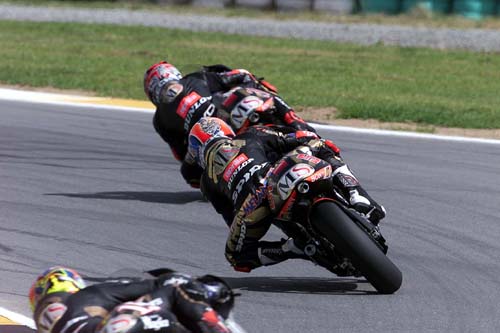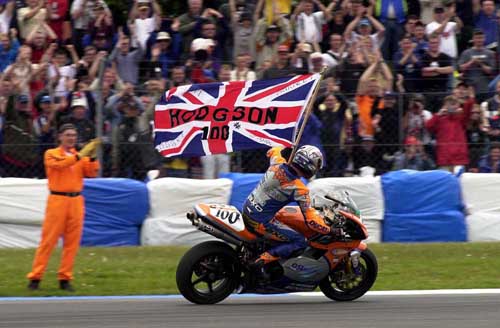Village people replace car boot sale.
When Formula One supremo Bernie Ecclestone visited a MotoGP paddock around ten years ago he was alleged to have commented it looked more like the site of a car boot sale than an international motorsport event.
A return visit by the maestro would certainly take longer than it did a decade ago because even he would have to admit that the television advert is right and that size matters.
When Formula One supremo Bernie Ecclestone visited a MotoGP paddock around ten years ago he was alleged to have commented it looked more like the site of a car boot sale than an international motorsport event.
A return visit by the maestro would certainly take longer than it did a decade ago because even he would have to admit that the television advert is right and that size matters.
The present day MotoGP paddock is three times bigger than its Formula One counterpart and, while it does not pretend to match the pristine clinical layout of the four wheel corporate show, that car boot sale tag has long disappeared. Not only are there far more team vehicles in the MotoGP paddock - because there are many more teams - but the majority of the riders and their families actually live on site over a grand prix weekend which produces its very own special village atmosphere, despite all the noise and activity.
In 1992, the grand prix paddock took up a minimum of 15,000 square metres but, today, the size is over twice as big with a minimum of 32,000 square metres required to house the teams at the European races. That space has to accommodate 230 vehicles - and that does not include car parks or the television compound.
Getting everyone of those 230 vehicles parked in the right place and at the right time is the stuff of nightmares. Not everybody is ever going to agree that the space allocated to them is near enough their garage, the electricity supply and the loos. Throw in language difficulties and personal rivalry, and you have all the hallmarks of a good old-fashioned 'barney' every two weeks when the 'wagon train' arrives at a new circuit.
The first man they meet at the paddock gate is the IRTA paddock manager Geoff Dixon, who has been instrumental in MotoGP losing that 'car boot sale' over the last ten years.
''It's like completing a giant jigsaw puzzle - we open the paddock gates at 0800 on Wednesday morning and hope to have 80 per cent parked by midday,'' Dixon revealed, ''It would be a nightmare if we were not organised but, with the help of the computer and aerial photographs of each paddock, we know exactly where everybody should be before they arrive. Of course, there are disagreements, but most people understand how tight the space is and how we are trying to promote the sport.''
In 1992, just 33 articulated lorries carried the teams' bike and equipment to each race. Today, a staggering 108 articulated lorries do a similar job, and it's a good thing that Geoff Dixon and his team have never forgotten their driving skills.
''We still have to jump into the cabs and park some of the artics if they are out of line or in the wrong space, but nothing like as many as we used to,'' he confided, ''The changes over the last decade are enormous. The biggest difference between us and other major European motorsports is that so many people actually live in the paddock. Out of those 230 vehicles in the paddock, 140 of them are team transport, but the other 90 are living accommodation. Thirty-six of those are American style motorhomes which take up a great deal of space.''
Feeding all those people and their guests has produced 36 separate hospitality units at each European race.
''In fact, we have 38 units at the Spanish race to feed the teams and their guests, with every two rider team being given the space for hospitality, '' Dixon explained, ''As far as team vehicles go, every 500 team can have a truck per rider while, in the 125 and 250, with a couple of notable exceptions, they have a truck per team. The two events I dread the most are at Donington and the Sachsenring because the space is so tight. I don't think there is another sport in Europe that has such a big travelling circus. We are three times bigger than the Formula One paddock, but the atmosphere is more like a village, especially in the evenings with so many people living in the paddock.''
The West Honda Pons team is typical of a modern day major two-rider MotoGP team that travels around 65,000km to compete in the ten European grands prix each season. From its base in Barcelona, the team takes a maximum of 25 personal to each race, ranging from team director Sito Pons to hospitality manager Antonio Martin.
It will take a maximum of ten vehicles to cause Geoff Dixon and his team a few more grey hairs. There are the two team trucks plus the West Honda Pons hospitality unit, and Loris Capirossi's and Alexandre Barros' motorhomes. Up to five cars are required to transport everybody, around although they are not parked in the paddock.
In addition to the expected team personal, both Capirossi and Barros bring extra people to help them concentrate on winning races. Loris' father drives his motorhome round Europe, while he is always accompanied by his personal trainer Roberto Brussi. Alex also has a motorhome driver with Rodolfo Hernandez, his personal trainer, a constant companion.
When the teams travel to the six non-European grands prix, it's a very different story - and very different problems for the likes of Geoff Dixon and West Honda Pons team co-ordinator, Eva Emora, as no trucks, no accommodation and plenty of paddock space bring a very different set of problems.
In the meantime, back in Europe, the village will be in full swing among the rolling hills of glorious Tuscany in Mugello this weekend. As has become the norm, there will not be car boot sale in sight - or anything for sale less than a 'fiver' [around 15,000 lire] for that matter.

